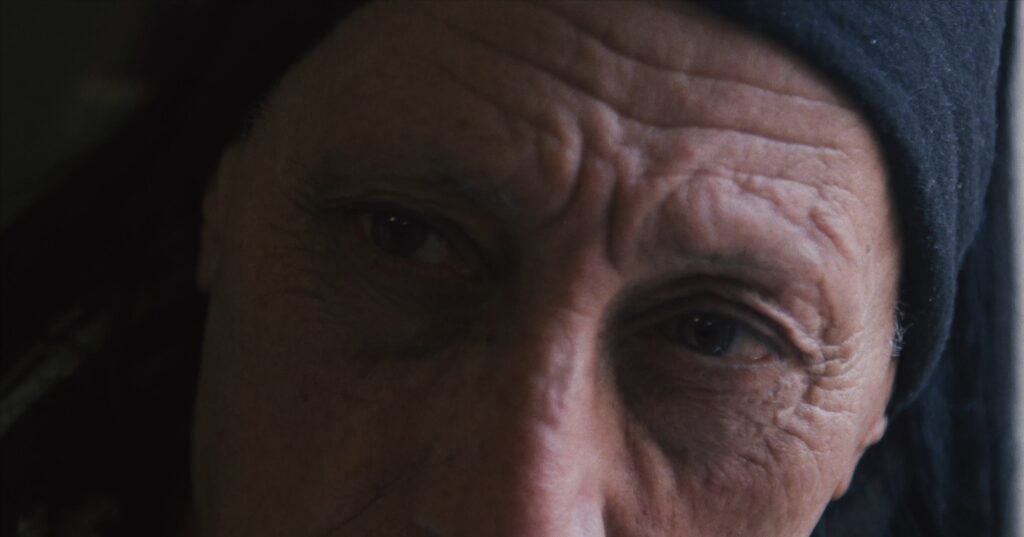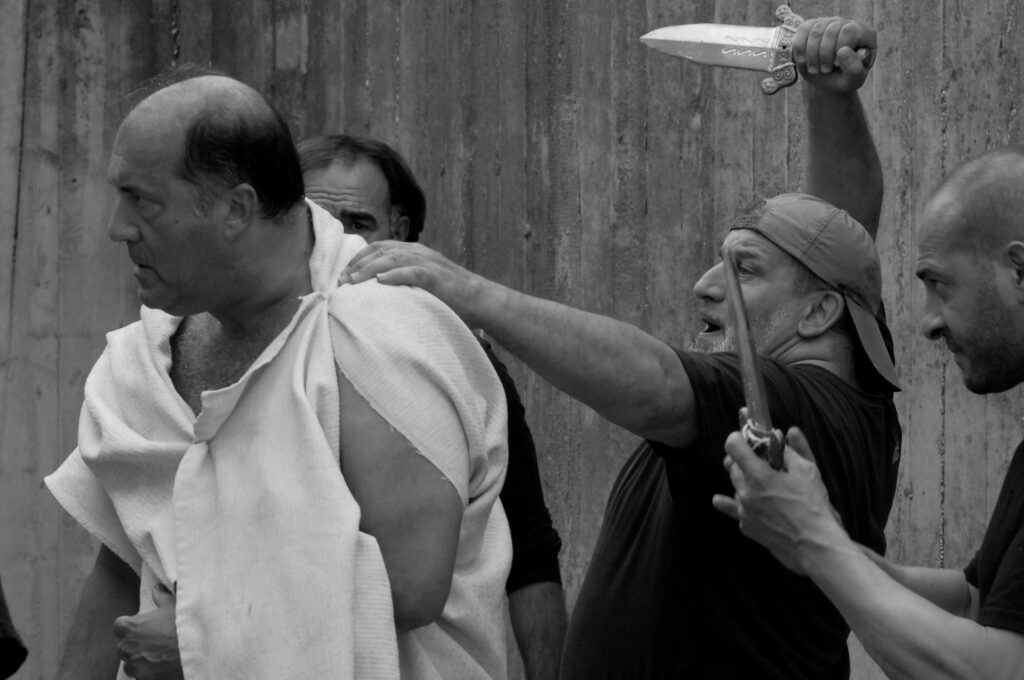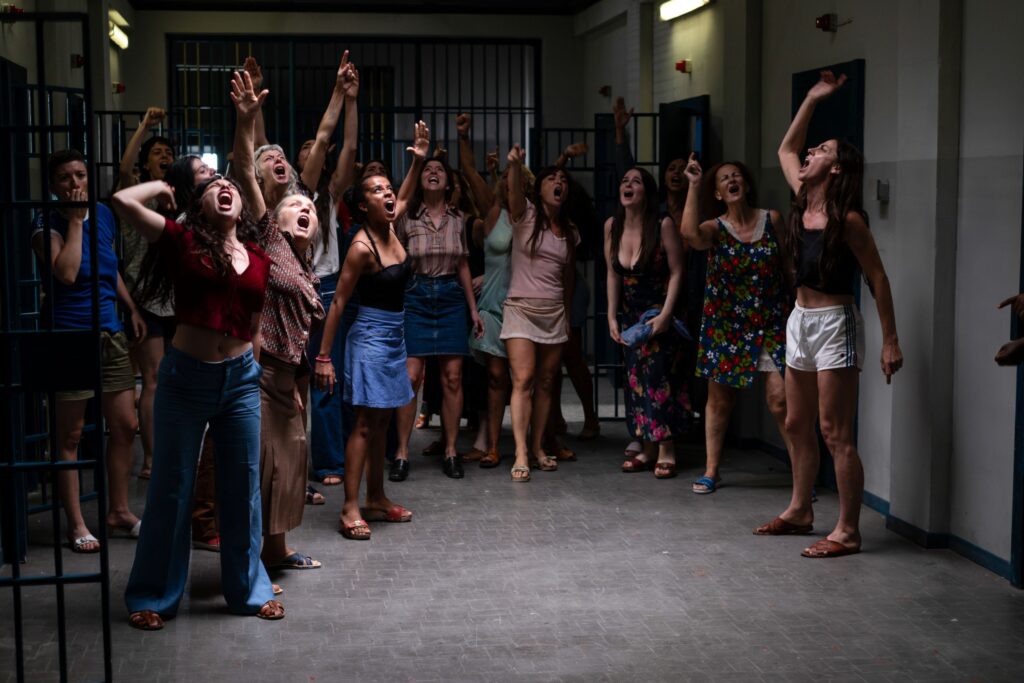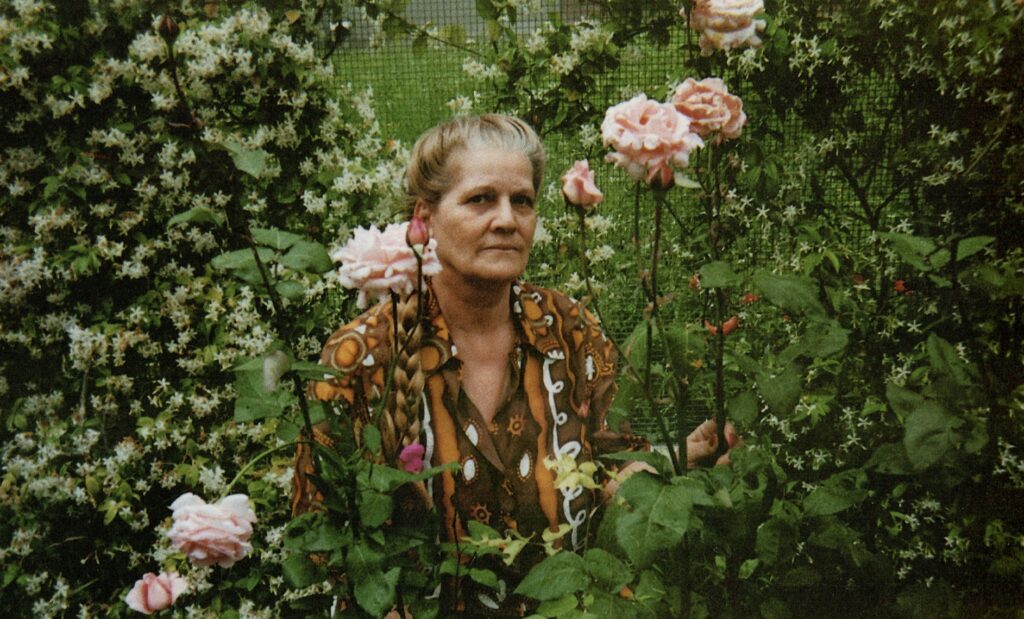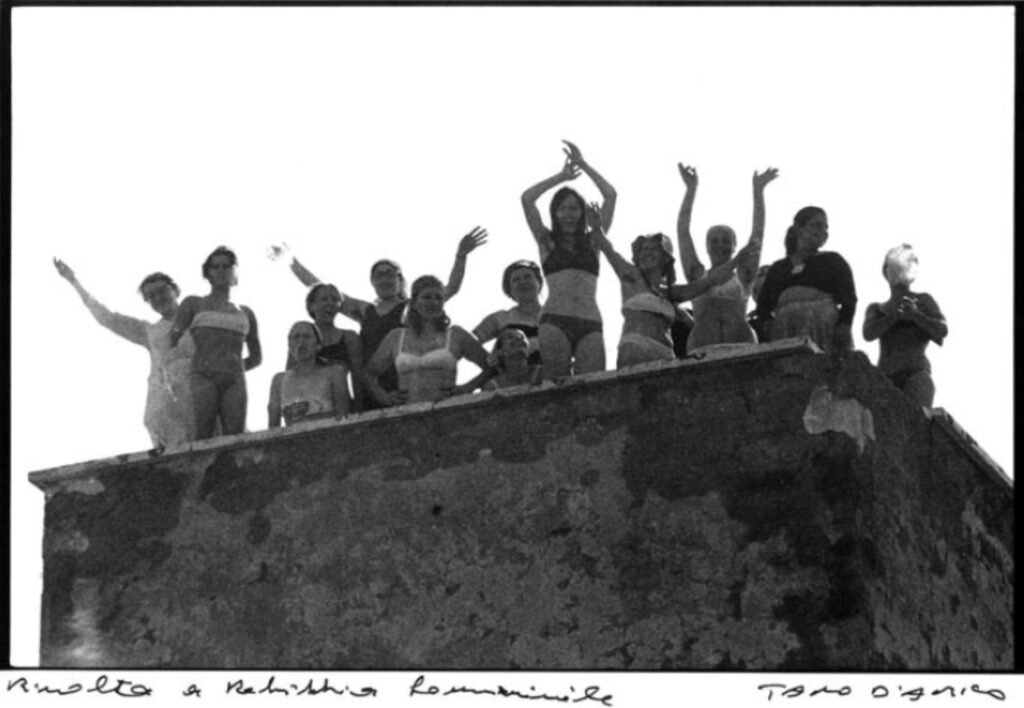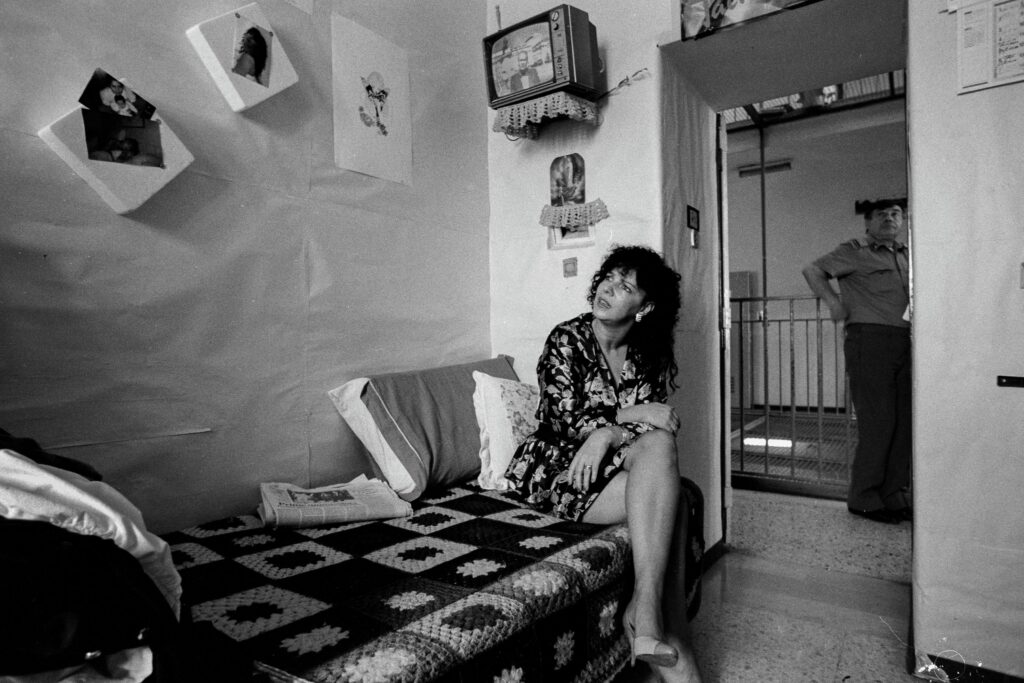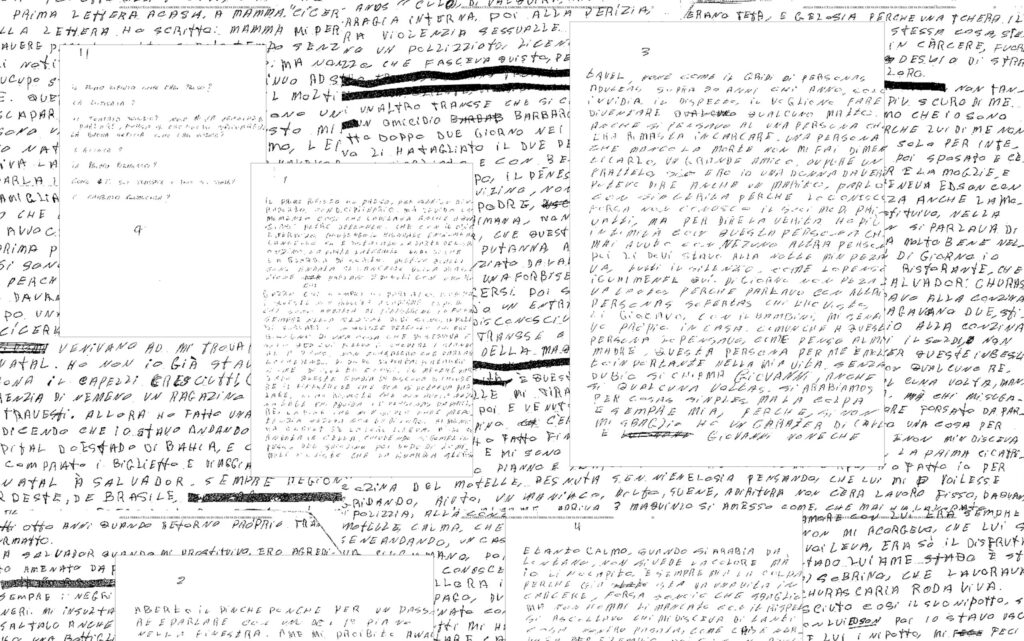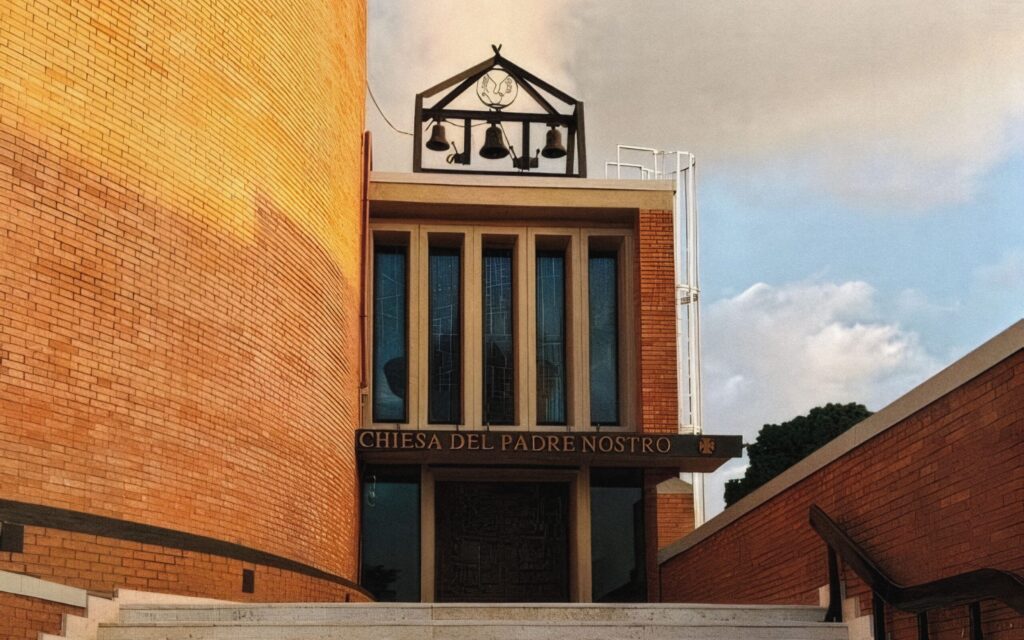They’re all tens
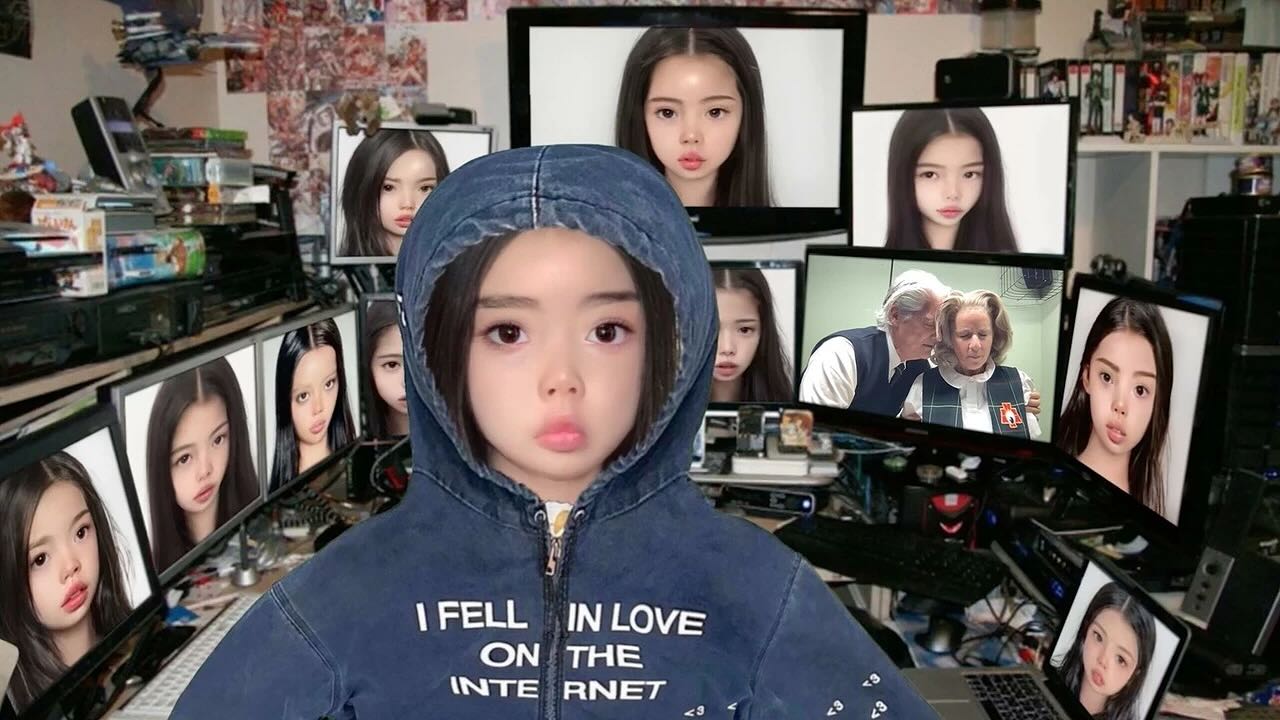
The Internet seems to manifest itself more intensely in New York than elsewhere. Perhaps this is because it was the first city to confront—and therefore the one most deeply exposed to—the idea that everything is available. Or perhaps it’s the proximity to major Western media that has, in some way, spread through the air a kind of lightheartedness in communication, or more simply, a way of coexisting with the chaos of overstimulation. I don’t know. But there’s something fundamentally New York, and certainly internet-like, in two cult podcasters taking a selfie in an ISIS t-shirt—unwittingly synthesising the essence of a neighbourhood that doesn’t even exist.
Among the various definitions attempting to capture the cloud of clout and gatekeeping, within which lies the essence of Dimes Square, my favourite has always been: "the first art scene with more articles written about it than notable creations."1 This sentence helps me to highlight—or, better yet, to conceal—some embarrassment in joining the long line of (illustrious: [1], [2] and [3] above all) predecessors who have tried to dissect the best-kept secret of the contemporary zeitgeist, to vivisect the lore. Italy, for some reason, stands out—if not as a supporter, then at least as a hasty tour guide.
Exactly like Platform 9¾ in Harry Potter or the non-existent island in Peter Pan (a book which, incidentally, shares further parallels with this topic), Dimes Square, as mentioned, doesn’t exist: it appears only to those predisposed to see it, like a kind of hyperstition brought into the present. To begin with, it’s not a square but a triangle—revealing, from its very definition, a distortion of reality that recurs throughout this story. The very name “Dimes Square” originates from a deli that opened in 2013 between Chinatown and the Lower East Side. Its founders, former wellness-obsessed models, recount that the name “Dimes” (American slang for the 10-cent coin) came from the fact that, in their view, all the clients were “tens”—stunning, top marks. The hyperbole, like everything in the neighbourhood, is a blend of sincerity and fabrication, just like the phenomenon it would later come to name. And the pun on the far more famous Times Square hints at the thin line between being and performing—a line along which much of the tale unfolds in this small cluster of streets across the ocean.
Dimes is a vibration—or better, a shift in the vibration (but we’ll come back to that)—as intangible as it is pervasive in the cultural production that emerged around a micro-community in a micro-neighbourhood in New York. It’s a ten-hour film that feels more like a hallucinatory TikTok scroll than a film. A podcast where two thirty-year-olds talk about their periods for twenty minutes in ASMR. It’s writing lists of “slow” and “slow” (both literally and ironically) people on Substack. Publishing a “news” magazine about a group of twelve friends. Staging a play about a tiny circle of neighbourhood micro-influencers. Or assuming multiple internet personas simultaneously, while consuming dozens of memes and schizoposts a day. It’s producing sweaters that unironically replicate Chinese knock-off misprints, or celebrate the alliance between Brad Pitt and Angelina Jolie. It’s a part-time modelling agency. And, for the overwhelming majority, it’s a mix of very young, wealthy, white, and not necessarily heterosexual people.
All of this, more than a structured artistic scene, is an ecosystem of signals, features, and products hovering at the boundary between performance and reality; where culture is a remix, community is an audience, and identity is an interface. It’s not a project, but a real-time mythology.
Always defined in the negative, Dimes Square is not Brooklyn: it’s Manhattan. This isn’t a geographical statement, but a declaration of intent. As is well known, Brooklyn was once—at the dawn of the 2010s (or the twilight of the 2000s)—the cradle of hipster culture: fixie bikes, a vintage obsession, lumberjack shirts, cuffed skinny jeans, circus ringmaster moustaches, exposed-brick coffee shops, and a cult of authenticity. It was the millennial utopia—dreaming of working from anywhere with a silver laptop, sipping lukewarm maté, subconsciously haunted by the 2008 financial crisis. A shock that temporarily killed the future and replaced it with the past, rejecting capital and embracing authenticity as its emblem. But it was also the breeding ground of the young liberal left and its most reviled product: political correctness. Manhattan, across the river, watched all of this—as only Manhattan knows how—with suspicion and disdain, waiting with relative patience for the right moment to respond.
In the years around the turn of the millennium, the triangle of streets crossed by Canal Street, near Chinatown, was dotted with electrical appliance shops, local bakeries, and Chinese restaurants. The neighbourhood’s cultural claims to fame were essentially two. The first: New York’s Jewish intelligentsia had famously been based in the area for decades. The second: since 2001—at 45 Canal Street—one of those old washing machine and hi-fi shops had been taken over and transformed into one of the most eccentric and offbeat art galleries on this side of the world: Maccarone. The steady flow of artists, models, art directors, journalists, art students, and writers brought with it a network of collateral businesses catering to their pre- and post-opening needs: cafés, bars, restaurants, nightclubs. The neighbourhood became another pin on the Downtown map, and property prices rose. Maccarone sold up—same old story. In the meantime, locals and habitués began (post)ironically referring to this small cluster of streets as Dimes Square—partly mocking the far more famous Times Square, partly riffing on the restaurant and deli Dimes.
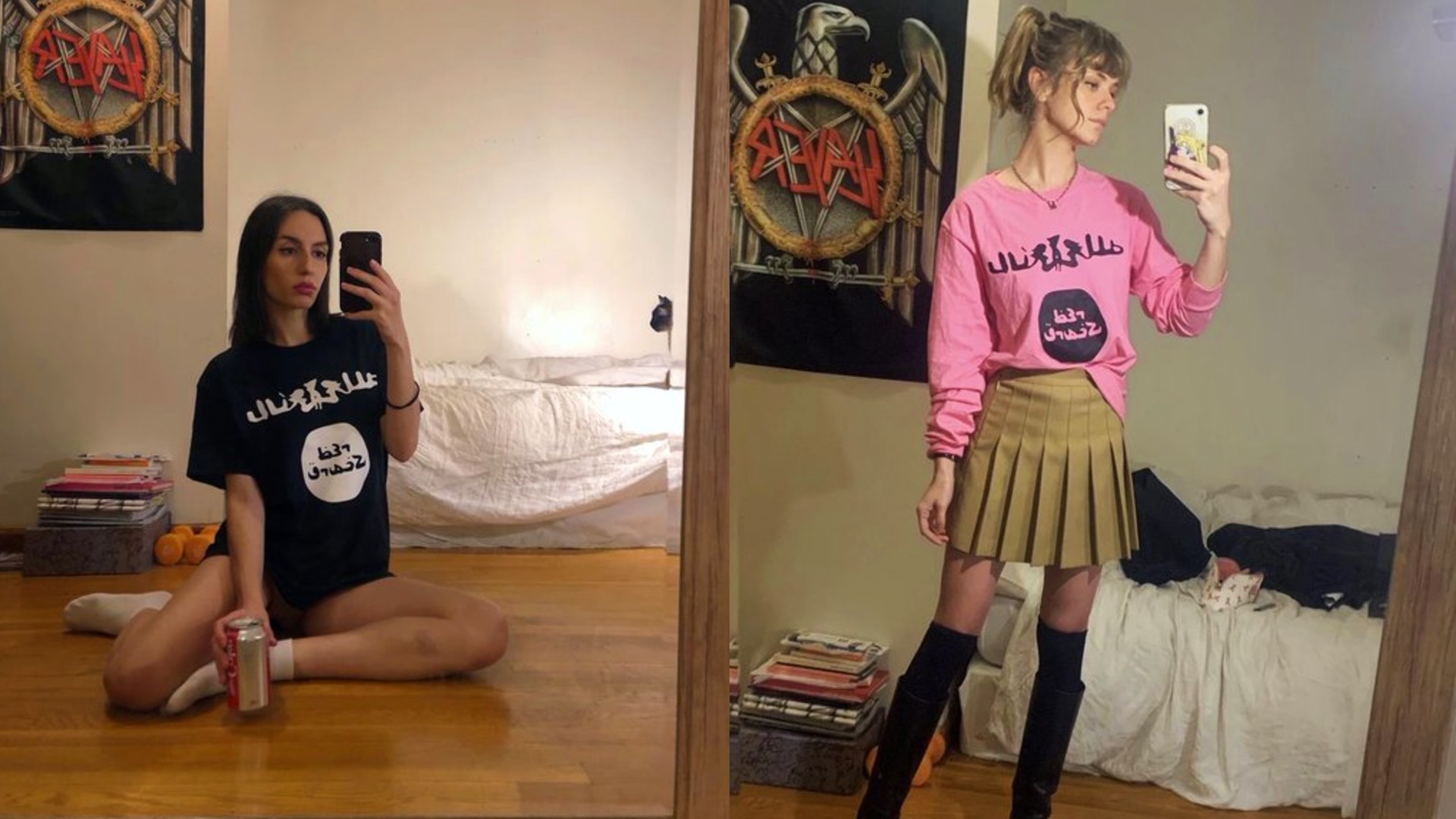
Then, at a certain point, COVID arrived.
In fact, several months before the pandemic hit every corner of the globe, journalist and writer2 Dean Kissick wrote in the pages of Spike that the "fringe" of exhibitions—the chats, meetings, gossip, after parties—had gradually become more interesting than the exhibitions themselves. We’re not concerned here with analysing the state of contemporary art,3 but rather with noticing how, for the first generation raised with social media, the background buzz has become more captivating than the discussions themselves, micro-celebrities more fascinating than VIPs, and influencers, preferably micro, more interesting than creators. In essence, these are the dynamics of legacy media translated into micro-networks, visible to anyone. And if there’s anyone who has made this underlying vibe their flag, it’s a radio based in Dimes Square.
At Montez Press Radio, anyone can propose a show. And this is still quite evident when tuning in at any time to one of the station’s two channels. Unlike their far more reserved British counterparts, MPR shows include raunchy karaoke from local homeless people, experimental radio dramas, queer-insurrectionist poets, bizarre overlaps of noise and violins, online erotic story readings, and who knows what else. Anyone, then, but preferably someone with an interesting person. And these days, anyone who possesses that quality is likely also an internet person, and almost never do the traits of the character align with those of the real person: social media becomes a theatre, a reality show in which only the edges remain real, while the inside is a performance. It was the signal Manhattan had been waiting for to exact revenge on the Brooklyn hipsters obsessed with authenticity: the pandemic proved, inevitably, to be the final nail in the coffin of their relevance.
On the other side of the East River, in Brooklyn, dominated by millennial hipsters and liberals, there was a constant buzz of face masks and hand sanitiser. Even if just for reasons of identity pride, the (younger and more unconventional) residents of the triangle that would soon become known as Dimes started to leave their homes after three months of forced confinement, paying less attention to the protocols. Gathering outside, in bars that had gained square metres of outdoor space, gleamed with a new light, reflected in the mirror of imminent danger. While the more reasonable and composed population across the river branded them as reckless and complacent—perhaps, deep down, envious of the same freedom they themselves flaunted ten years earlier—the shapeless mass of skaters, podcasters, part-time models, and memelords discovered the perverse allure of doing something slightly wrong at a time of great general confusion. In this breeding ground, the microcosm of that triangle of streets began to emerge, along with its first disjointed cultural products.

And of all the activities we did without for months, one in particular, in the Dimes Square that was nurturing its cluster of micro-celebrities and platforms, took over: hyper-gossip. By hyper-gossip, I mean an accelerated, distributed, and memetic form of gossip, which no longer concerns just mainstream celebrities but feeds off semi-anonymous, micro-famous figures, visible only within hyper-localised social circles but digitally amplified. It’s a gossip that spreads on Substack, podcasts, Discord, and private profiles, where anyone can be at the centre of the narrative for just 24 hours. It’s no longer necessary to be famous to be relevant: you just have to be in the right place, with the right people, in the right feed. Hyper-gossip is not just the story of "who did what," but a way to define status, affiliations, fleeting hierarchies, and shared values in an age where identity is built performatively, through content that mixes confession, aesthetics, and social strategy.
It’s not a project, it’s a real-time mythology.
Anyway, talk of Dimes Square began to circulate, and people started hearing about it in the months between the first and second Covid lockdowns. The usual Dean Kissick would later describe it as a “magical” period. It was the moment of the first “vibe shift”—initially theorised by angelicism01 (whom we’ll return to later), but popularised by strategist and cultural theorist Sean Mohanan in an article for The Guardian. The first vibe shift marked that indefinable moment when it became clear that something, culturally, was changing. It wasn’t a movement, nor a distinct trend, but a collective perceptual shift: a change in atmosphere, tone, aesthetics, and desire. A transition from an era dominated by post-internet cynicism and hipster irony to a new phase shaped by faux spirituality, simulated intimacy, selective nostalgia, and the performance of authenticity. The vibe shift didn’t produce a singular aesthetic, but it revealed a widespread longing for the “new” in a context where everything already felt seen.
The most significant point in all of this is that none of it is exceptional—and the most surprising thing is that it doesn’t even try to be. There’s something incredibly liberating about lowering the bar of expectation for a cultural product, both in making it and in consuming it. Whether it’s a spontaneous retreat from the sensory overload this generation has been subjected to, or a natural response to the widespread attention deficit that followed—I couldn’t say. What I can say, with some certainty, is that they do it better here than anywhere else.
If you look closely, threaded through the posts and accounts that have emerged from Dimes, there’s an implicit middle finger raised to the #legacy #bluepilled #mainstream media looking down on the neighbourhood from their surrounding glass towers. And it’s baked into the decision to go against the grain at every creative turn. If they polish their graphic design, we do ours badly. If they use a vocabulary attuned to diversity and inclusion, we couldn’t care less. If they sincerely support Kamala, we ironically back Trump. If they love to talk about international politics, we stick to neighbourhood gossip. And so on—as if land of the free now meant the freedom to be awful. And if there’s one concept the contemporary right has successfully and unequivocally claimed, it’s precisely that: the freedom to.

It’s no secret: Dimes Square, if not explicitly alt-right, is at the very least slightly reactionary. This may well be the most surprising aspect of the whole phenomenon: not since the days of Futurism—which Dimes Square also shares a blind fascination with new technologies—have we seen an intellectual avant-garde align itself with a non-progressive mindset.
In truth, as often happens, signs of a seismic shift had already begun to emerge. Disillusioned by the downfall of their beloved Bernie Sanders, and uneasy with both the persona and overly complicit narrative surrounding Hillary Clinton, a portion of the radical-progressive left—especially across the literary American coasts—began adopting a more insolent, memetic language, laced with unorthodox views that, until then, had largely belonged to the emerging alt-right. They called it the 'dirtbag left’, and I’m not quite sure how to translate dirtbag, because you’d be tempted to say “the asshole left,” whereas the original term points more to a kind of self-exiled figure living (happily) on the margins of society—more like a disillusioned hippie. The main cultural touchstones of the movement are two podcasts, one of which in particular mirrors, in its own trajectory, the small-scale story of Dimes Square itself—alongside its most recognisable figure: Chapo Trap House and Red Scare.
Red Scare, hosted by Dasha Nekrasova and Anna Khachiyan, is a striking example of how a growing discontent with the cultural taxonomy of the 2010s played a key role in the rupture that took shape during the first post-pandemic summer. Dasha and Anna—and the early seasons of Red Scare—could easily be placed within the dirtbag left spectrum mentioned earlier: a core of broadly socialist political and cultural convictions, wrapped in a layer of political incorrectness, barely concealed critiques of contemporary feminism, flirtations with Catholicism, and a thinly veiled irritation toward the identity politics that had come to dominate the discourse and actions of the Democratic Party (and the entire contemporary art world) following Donald Trump’s first election. And yet it remained the podcast hosted by the same person who went viral in the YouTube video still titled “Dopey Infowars Reporter Gets OWNED By Super Chill Socialist,” or “Sailor Socialism.”
From Red Scare, things began to shift—just as they did for many—around the first wave of COVID. The critiques of feminism became openly anti-feminist, the post-ironic fascination with Catholicism turned into genuine religious practice, the slur “retard” became a recurring meme of the podcast (and of anything Dimes-related), and key figures of the new American right—like Peter Thiel, Curtis Yarvin, and Steve Bannon—began to appear as guests, greeted with a certain amused reverence as fellow edgelords. Something, indeed, was shifting. But not the tone of voice the two hosts used, which always felt like a hushed conversation about their personal lives—a notable difference for anyone expecting Red Scare to be the American equivalent of La Zanzara. That colloquial, intimate, domestic tone remains one of the programme’s most distinctive and most imitated features. Dasha, from online micro-celebrity, blossomed into a VIP IRL—embodying, in some sense, a fast-forward version of Chloë Sevigny. Meanwhile, the paradigm of traditional journalism was gradually being replaced—both in form and content—by the shape of gossip.
The paradigm of traditional journalism was gradually being replaced by the shape of gossip.
In total contradiction to decades of dystopian and cyberpunk literature, the true consequence of the technological revolution has been the rise of the attention economy. And its most powerful cultural forms are: personality, identity, and image. An artist’s success—regardless of their medium—is now determined by how effectively they weave these elements into the stories they tell about themselves.
This theorem has several corollaries, all of which are visible in what’s happened in Dimes Square. First of all: once self-narration becomes entirely malleable, life itself merges with theatre. It’s no coincidence, then, that in discussions of contemporary literature, the word autofiction keeps cropping up. In 2022, Matthew Gasda staged a play—performed in a Dimes Square apartment, with Dimes Square actors—titled Dimes Square, in which essentially nothing happens, and which ends with the line: “We are living through the dumbest time in human history.”
My First Book by Honor Levy, the short stories of Sierra Armor, and Fuccboi by Sean Thor Conroe each offer, in their own way, a different version of this paradigm, injecting their prose with a shifting degree of detachment from reality. The same formula can be found in Heavy Traffic, a literary (auto)fiction magazine, or in the foul-mouthed posts of Spite, an “open magazine” that resembles—for better or worse—4chan green texts more than any traditional publication. But that’s exactly the point: to collapse any boundary between art and “content.” And perhaps it’s no surprise that this is happening in the city where, more than anywhere else, the borders between “life” and “fiction” have always been blurry.
If journalists embody “everything that’s wrong with official culture,” then gossip—the farthest thing from respectable journalism—becomes, for Dimes, the official mode of self-narration. Which makes perfect sense, in a neighbourhood literally populated by micro-celebrities and DIY media.
The ION Pack, angelicism01 and The Drunken Canal are three unrelated but interconnected phenomena that show how Dimes has channelled the energies of the vibe shift into gossip talk. The ION Pack is arguably the least interesting of the three, but probably the best known—especially after the identities of its previously anonymous hosts were revealed. That twist, particularly effective, forms part of a broader evolution in the shaping of T.I.P.’s identity: at first a meme page mocking the American indie film world,4 then a video interview show featuring the same former targets, all wrapped in a vibe-shifted aesthetic—poor lighting, questions that veer between awkward and dull, and a kind of complicity between host and guest that’s almost entirely foreign to the Italian media sphere.

Between film, literature, gossip and meme culture lies perhaps the most mysterious, incomprehensible and compelling phenomenon of the entire scene—its “father” and theorist: angelicism01. Summarising its contours is nearly impossible (in Italian, I’ve tried to sketch them out in this article for Zero and this interview for Rivista Studio), but here we’re interested in two facets of this unstable polygon: the newsletter Theoretical Gossip of the XXI Century, and the film Film01. Of the former, sadly, little remains, as it has been repeatedly subject to acts of self-censorship by its creator—though a few fragments survive on Internet Archive: lists of retards and “retards,” hallucinatory pamphlets on NFTs at Treblinka, comparative phenomenological analyses between Kanye West and human extinction, references to ultra-Orthodox Catholicism (including the name angelicism itself), and a proposed massacre of The Cut’s editorial team, which is, in fact, the theoretical manifesto of the vibe shift.5 Plus: gossip (whether accurate or not) about the entire Dimes Square scene, post-ironic, post-political memes,6 and an equally delirious community of followers and clones.
All of this culminated in his opus magnum, Film01, now available online in one of its many cuts, but until less than a month ago, accessible only in real life, at one of the dozens of screenings organised by his disciples around the world. Film01 is the most Dimes thing imaginable: a wild crystallisation of a specific moment in internet culture (and thus, in a sense, global culture) rendered as a catatonic mash-up of angelic intellectual twenty-somethings, nightcore edits, and a Fluxus-like poetics somewhere between Messiaen and an anime nightmare. As Caroline Busta perfectly put it, Film01 is: “a story of imminent extinction and an infinite urge to broadcast oneself across the network. [...] A frenetic sequence of sunsets, sad girls dancing in their bedrooms, viral POVs, TikToks and Godard talking about the iPhone, all layered into a kind of digital stream of consciousness that blurs every boundary between author, archive, and collective hallucination.”
Not coincidentally, at the height of his edgelord fame, a post from angelicism01’s newsletter called for the massacre of the entire editorial staff of The Drunken Canal, the hyperlocal magazine about Dimes Square, which, more than a neighbourhood rag like those of Lorenteggio or Tor Vergata, seemed more like a fashion magazine laid out by a drunk and written by a junkie. Founded by two twenty-three-year-olds (at the time), the tone of the approximately 28 pages of each issue ranged from astonishment over the discovery that “17 x 3 = 51” to photos of the founder wearing a shirt that said “I’M PUTIN”, from a list of tips on how to have sex on ketamine to inside jokes about the scene and the obligatory micro-gossip of the neighbourhood.
It’s no surprise that this is happening in the city where the borders between “life” and “fiction” have always been blurry.
The answer to the question of what’s extraordinary in all this (and I haven’t even mentioned dozens of other examples, like the countless -cellectuals accounts, @themasterofcum, Sex Magazine, Praying, Mike Crumplar’s newsletter, Honor Levy’s TikTok accounts, the parties for Donald Trump’s election at Sovereign House, the brief yet powerful incursion of Urbit into the neighbourhood, the zines from No Agency / No Erotica, Reena Spaulings’ exhibitions, and so on) is: nothing. Or rather, the truly extraordinary aspect of Dimes Square and its “offspring” is the self-mythologising of the scene by the scene itself—a phenomenon that’s exquisitely New York. Just, with different tools compared to two illustrious predecessors.
The bohemian microcosm evokes, in certain ways, the dysfunctional energy of Warhol’s Factory, the toxic glamour of Studio 54, and the hyperrealist rawness of New York as told by Larry Clark’s Kids. Just like back then, today we see art, fashion, excess, and irony mixing, but with a post-Internet filter saturated with layered aesthetics and a constant sense of self-reference. If Warhol turned his friends into pop icons and Bernadette Corporation mocked the fashion system from the inside, today the semi-anonymous influencers of Dimes Square do the same on Substack, Instagram, and self-produced podcasts, balancing between parody and authenticity. More than a return, it feels like a glitchy remake—where nostalgia becomes strategy.
It must be said that the Vibe Shift inaugurated in the neighbourhood in 2020-2021 remains the most interesting cultural phenomenon of recent years, so much so that by comparison, any other content instantly fades and ages. It was a spontaneous short-circuit between post-ironic aesthetics, a return to analog, micro-publishing, nihilistic fashion, and semi-philosophical podcasting, which brought a rare sense of urgency back to urban creativity. For the first time in years of platforms, algorithms, and creative homogenisation, it felt like something new—or at least something alive—was really happening, offline, between half-empty cocktail bars and newsletters written like manifestos. The vibe wasn’t just the style; it was an attitude: cynical but curious, self-aware but seeking meaning, always straddling the line between play and theoretical gesture.But, with all that said: why does it matter? And, above all, why does it still feel so relevant today, even though four years have passed?
Dimes Square is everywhere, and yet it remains elusive. It’s on Substack, on Instagram, at certain Milanese events, and in European podcasts that talk over each other pretending intimacy. It’s imitated but never truly replicated. Why did it happen there, in that way? Maybe it was just a post-pandemic reflux. Or maybe it was the first, clumsy attempt to redefine what it means to “be online” after the great social media binge.
The point isn’t just what it was—but the fact that, perhaps for the first time in a long time, it made us believe something new could still happen. That there was life, noise, desire—beyond the algorithms. And in an age when everything is content, this is no small thing. The real question today is whether there’s room for another similar short-circuit. And if we really want it to happen again.
- Brad Troemel, from his Cancelled Report. ↩︎
- And later, guardian spirit of the scene. ↩︎
- Spoiler: It's awful. ↩︎
- Possibly the last remaining cultural artifact of the hipster authenticity movement—which, fittingly, became a target of an ill-fated anti-woke film festival held in New York. ↩︎
- “This chance. This infinity. This rising up of thoughts in the face of God. This savage shifting into grace. This Worm-like slinky of ontological and changeful change. A psychic change. A greater health in the face of annihilation. Hanging out in Cape Town with the hoes. Seeing Charlotte Fang in Buzzfeed. It’s why someone writing for The Cut who is a staff writer for the miasma of degenerescent Bidenism called The Atlantic will always misread what’s happening when it comes to ‘vibe’." ↩︎
- Including the use of Simone Weil’s texts to call Donald Trump 'beautiful.' ↩︎
